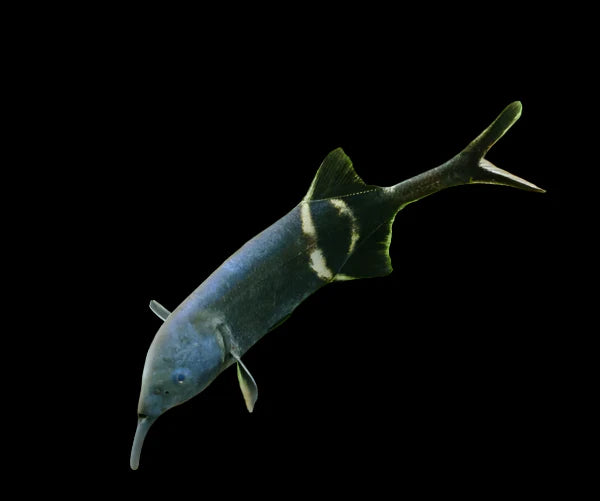Description
Long Nose Elephant Fish – Graceful, Intelligent, and Truly One of a Kind
(Gnathonemus petersii)
The Long Nose Elephant Fish, also known as the Elephantnose Fish, is one of the most intriguing and intelligent freshwater species in the aquarium world. Native to the slow-moving rivers and streams of Central and West Africa, this fish is famous for its elongated "trunk-like" mouth extension, which it uses to forage and explore. Its sleek, dark body and graceful swimming give it a mysterious, almost alien beauty that captivates anyone who sees it.
Key Features:
-
Distinctive Trunk-Like Snout: Used to navigate and locate food with electro-sensory precision
-
Glossy, Streamlined Body: Dark black to chocolate-brown with subtle iridescence
-
Highly Intelligent: Uses electrolocation to interact with its environment—can even recognize its owner
-
Medium Size: Grows to 20–25 cm (8–10 inches) in captivity
Tank Requirements:
-
Minimum tank size: 200 liters (55+ gallons)
-
Temperature: 24°C–28°C (75°F–82°F)
-
pH: 6.5–7.5
-
Prefers dim lighting, soft substrate, and lots of hiding spaces like driftwood, caves, and PVC pipes
-
Sensitive to water quality—requires excellent filtration and stable parameters
Compatibility:
-
Peaceful but shy—best kept with calm, non-aggressive tankmates
-
Avoid fin-nippers and fast feeders that may outcompete it for food
-
Can be kept alone or in very small groups (in large tanks) if introduced carefully
Feeding Tips:
-
Carnivorous—feeds primarily on live or frozen foods such as bloodworms, blackworms, and brine shrimp
-
May accept sinking pellets with training
-
Feed in low-light periods or just before lights out to match their nocturnal nature
Why Choose the Long Nose Elephant Fish?
Fascinating, elegant, and unlike any other aquarium species, the Long Nose Elephant Fish is ideal for aquarists seeking something truly unique. Its intelligence, distinctive appearance, and graceful movements make it the crown jewel of any peaceful, well-maintained freshwater setup.
Click & Collect
Livestock will only be bagged once you arrive, or if you contact us in advance to request it ready beforehand.
Local Delivery
Order anything from our in-store range and have it delivered right to you.
-
Minimum spend: £50
-
Delivery up to 10 miles: £10
-
Delivery up to 25 miles: £20
Distances are measured “as the crow flies”, not by road.
Once your order is placed, we’ll be in touch to arrange a suitable delivery date and time.
Please note, delivery may take a little longer as we often group orders together to build an efficient delivery run.
Important: If you’re ordering a large aquarium, please ensure someone is available to help unload the van on arrival.
Dry Goods Delivery
-
DX Express: 1 working day, same-day dispatch before noon 0-75kg
-
Express Pallet: 1–3 working days 75-500kg
If you'd like to add more items to an existing order that hasn't yet been dispatched, please place a Click & Collect order and leave a note asking us to combine the orders.
Please note: We currently only dispatch parcels Wednesday to Friday.
Pre-Order
Want the full details? Check out our Terms & Conditions.
Livestock Delivery
Thursday Delivery – £24
-
Dispatched Wednesday afternoon
-
Delivered Thursday before 1pm
-
Order by Wednesday 12 noon
-
Minimum spend: £50
Friday Delivery – £24
-
Dispatched Thursday afternoon
-
Delivered Friday before 1pm
-
Order by Thursday 12 noon
-
Minimum spend: £50
Saturday Delivery – £29
-
Dispatched Friday afternoon
-
Delivered Saturday before 1pm
-
Order by Friday 12 noon
-
Minimum spend: £50
📦 Want to Add to an Existing Order?
No problem! Just place a Click & Collect order and leave a note asking us to link it with your original one (as long as it hasn’t been dispatched yet).
🛒 Dry Goods Now Included!
You can now include dry goods in your livestock delivery – perfect for topping up supplies in one go.
❄️ Please note: We can’t send frozen food with livestock – please order frozen items separately.
⚠️ Delivery Exclusions
Unfortunately, we’re unable to deliver livestock to the following postcodes:
Scotland & Isles:
AB30–AB56, DD8–DD10, DG3–DG9, DG12–DG14, FK17–FK21, KA18–KA19, KA26–KA30, PA20–PA38, PA80, PH3–PH40
Cornwall Isles: TR21–TR25
All of the following postcodes are excluded:
BT, HS, IM, IV, JE, KW
Plus Channel Islands and Shetland Islands
Payment & Security
Your payment information is processed securely. We do not store credit card details nor have access to your credit card information.

